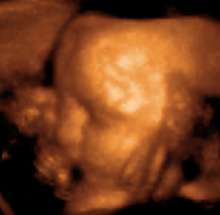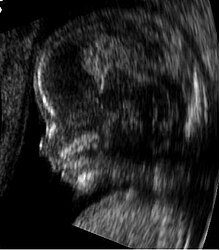Ultrasound: Difference between revisions
ChunderHog (talk | contribs) No edit summary |
|||
| Line 84: | Line 84: | ||
*[[hypersonic sound]] Article subject to cleanup |
*[[hypersonic sound]] Article subject to cleanup |
||
*[[Infrasound]] (sound at extremely low frequencies) |
*[[Infrasound]] (sound at extremely low frequencies) |
||
*[[Foundation for Focused Ultrasound Research]] |
|||
*[[Light]] |
*[[Light]] |
||
*[[Physics]] |
*[[Physics]] |
||
Revision as of 20:46, 27 September 2006
- For other meanings of "ultrasound" or "ultrasonic", see ultrasound (disambiguation).

Ultrasound is sound with a frequency greater than the upper limit of human hearing, this limit being approximately 20 kilohertz (20,000 hertz).
Ability to hear ultrasound
Some animals, such as dogs, dolphins, bats, and mice have an upper frequency limit that is greater than that of the human ear and thus can hear ultrasound. Children can hear some high-pitched sounds that older adults cannot hear, as in humans the upper limit pitch of hearing gets lower with age (a cell phone company has used this to create ring signals only able to be heard by younger humans). This frequency limit is caused by the middle ear that acts as a low-pass filter. If ultrasound is fed directly into the skull bone and reaches the cochlea without passing through the middle ear, much higher frequencies (up to about 200 kHz) can be heard. This effect (sometimes called ultrasonic hearing) was first discovered by divers exposed to a high-frequency (ca. 50 kHz) sonar signal.

Diagnostic sonography
Medical sonography (ultrasonography) is a useful ultrasound-based diagnostic medical imaging technique used to visualize muscles, tendons, and many internal organs, their size, structure and any pathological lesions. They are also used to visualize a fetus during pregnancy. Ultrasound scans are performed by medical health care professionals called sonographers. Obstetric sonography is commonly used during pregnancy.
- Ultrasound is generally regarded as a "safe test" because it does not use ionising radiation as in x-rays, nuclear medicine, or CT. But is a form of energy and scans should only be performed for a suitable medical indication by trained operators (sonographers). Scans performed for baby photos are considered by the profession to be unethical.
- The biggest danger of ultrasound is often considered to be misdiagnosis by untrained operators.
- A study on rodent fetus brains that are exposed to ultrasound showed signs of damage. Speculation on human fetuses can be in a range of no significant complications to variety of mental and brain disorder. The study shows that rodent brain cells failed to grow to their proper position and remained scattered in incorrect parts of the brain. The conditions of this experiemnt are different from typical fetal scanning because of the long dwell times. Care should be taken to use low power settings and avoid pulsed wave scanning of the fetal brain unless specifically indicated in high risk pregnancies.
Biomedical Ultrasound Applications
Ultrasound also has therapeutic applications, which can be highly beneficial when used with dosage precautions[1]:
- Treating benign and malignant tumors and other disorders, via a process known as Focused Ultrasound Surgery (FUS) or HIFU, High Intensity Focused Ultrasound. These procedures generally use lower frequencies than medical diagnostic ultrasound (from 250 kHz to 2000 kHz), but significantly higher time-averaged intensities. The treatment is often guided by MRI, as in Magnetic Resonance guided Focused Ultrasound.
- More powerful ultrasound sources may be used to clean teeth in dental hygiene or generate local heating in biological tissue, e.g. in occupational therapy, physical therapy and cancer treatment.
- Extracorporeal shock wave lithotripsy uses a powerful focused ultrasound source to break up kidney stones[2].
- Focused ultrasound sources may be used for cataract treatment by phacoemulsification.
- Additional physiological effects of low-intensity ultrasound have recently been discovered, e.g. the ability to stimulate bone-growth and its potential to disrupt the blood-brain barrier for drug delivery.
- Ultrasound is used in UAL (= ultrasound-assisted lipectomy), or liposuction.
- Doppler ultrasound is being tested for use in aiding tissue plasminogen activator treatment in stroke sufferers. This procedure is called Ultrasound-Enhanced Systemic Thrombolysis.
- Low intensity pulsed ultrasound is used for therapeutic tooth and bone regeneration.
- Ultrasound can also be used for elastography. This can be useful in medical diagnoses, as elasticity can discern healthy from unhealthy tissue for specific organs/growths. In some cases unhealthy tissue may have a lower system Q, meaning that the system acts more like a large heavy spring as compared to higher system Qs (healthy tissue) that respond to higher forcing frequencies. Ultrasonic elastography is different from conventional ultrasound, as both a transceiver (pair) and transmitter are used instead of one transceiver. One transducer (a single element {or array of elements} acts as both the transmitter and receiver to image the region of interest over time. The latter is a very low frequency transmitter. The latter acts to perturb the system such that the unhealthy tissue oscillates at a low frequency (single transmitter) while the healthy tissue does not resonate at such low frequencies. The transceiver, which operates at a high frequency (typically MHz) them measures the displacement of the unhealthy tissue (oscillating at a much lower frequency). The movement of the slowly oscillating tissue is used to determine the elasticity of the material, which can then be used to differentiate between healthy and unhealthy tissue.
- Ultrasound has been shown to act synergistically with antibiotics in bacterial cell killing.Citation list
- Ultrasound has been postulated to allow thicker eukaryotic cell tissue cultures by promoting nutrient penetration.Scientific Article
Industrial ultrasound
Ultrasound is also used in industry to find flaws in materials. Frequencies of 2 to 10 MHz are common but for special purposes other frequencies are used. Inspection may be manual or automated and is an essential part of modern manufacturing processes. Most metals can be inspected as well as plastics and aerospace composites. Ultrasound can also be used for heat transfer in liquids[3].
Ultrasound flow meter
Ultrasonic cleaning
Ultrasonic cleaners, sometimes mistakenly called supersonic cleaners, are used at frequencies from 20-40 kHz for jewellery, lenses and other optical parts, watches, dental instruments, surgical instruments and industrial parts. An ultrasonic cleaner works mostly by energy released from collapse of millions of microscopic cavitations near the dirty surface. The bubbles formed by cavitation collapse forming tiny jets directed at the surface. Home ultrasonic cleaners are available and cost about US $60 or more.
Ultrasound and animals
Rodents
Ultrasound generator/speaker systems are sold with claims that they frighten away rodents and insects, but there is no scientific evidence that the devices work; controlled tests have shown that rodents quickly learn that the speakers are harmless. However, the pitch used is well within the range that most children can hear, and can cause headaches.
Insects
There is evidence that ultrasound in the range emitted by bats causes flying moths to make evasive maneuvers, because bats eat moths.
Mosquitoes
There is a theory that ultrasound of certain frequencies, while not audible to humans, repel mosquitoes. There are computer programs available on the internet that claim to use this phenomenon for pest-control. There have been mixed reports about the effectiveness of this method towards mosquito-control.
Dogs
The dog whistle is used to call to a dog. It makes ultrasound at a frequency that dogs can hear.
Sonochemistry
Power ultrasound in the 20-100 kHz range is used in chemistry. The ultrasound does not interact directly with molecules to induce the chemical change, as its typical wavelength (in the millimeter range) is too long compared to the molecules. Instead:-
- It causes cavitation which causes local extremes of temperature and pressure in the liquid where the reaction happens.
- It breaks up solids and removes passivating layers of inert material to give a larger surface area for the reaction to occur over.
Both of these make the reaction faster.
Ultrasonic disintegration
Some sorts of ultrasound can disintegrate biological cells including bacteria. This has uses in biological science and in killing bacteria in sewage. See for example:-
- http://www.sanyogallenkamp.com/proddetail.asp?prodid=236
- http://www.iwaponline.com/wst/04209/wst042090073.htm
Ultrasound as a weapon
Modulated ultrasound carrying audio messages
See Modulated ultrasound.
Nonlinear Effects of Propogating Acoustic Wave
When an acoustic wave propagates through a material, it acts as a force that creates localized pressure. When a material is under pressure (as compared to some lower equilibrium pressure), the speed of sound increases because the molecules transmitting the energy are closer together. As a result, the wave travels faster during the high pressure phase than for the lower pressure section of oscillation. Consider a sinusoidal wave with a high peak. As a result of this nonlinear effect, the peaks of the wave travel faster than the dips (near zero). When the peaks travel faster, the shape of the wave changes, as the higher amplitude sections shift farther forward than the lower pressure part of the wave and the signal approaches more of a square wave than a sinusoidal one. Fourier analysis will show that this single-frequency wave will be changed into one that has much more than a single impulse in the frequency domain! This implies a non-linear system, as a linear one cannot output frequencies that were not a part of the input signal.
Other uses
Ultrasound when applied in specific configurations can produce exotic phenomena such as sonoluminescence. These phenomena are being investigated partly because of the possibility of bubble fusion (a nuclear fusion reaction hypothesized to occur during sonoluminescence).
Ultrasonic range finding
A common use of ultrasound is in range finding; this use is also called sonar. This works simiarly to radar: An ultrasonic pulse is generated in a particular direction. If there is an object in the path of this pulse, part or all of the pulse will be reflected back to the sender as an echo and can be detected. By measuring the difference in time between the pulse being transmitted and the echo being received, it is possible to determine how far away the object is.
Bats use a variety of ultrasonic ranging (echolocation) techniques to detect their prey.
See also
- hypersonic sound Article subject to cleanup
- Infrasound (sound at extremely low frequencies)
- Foundation for Focused Ultrasound Research
- Light
- Physics
References
- ^ Essentials of Medical Ultrasound: A Practical Introduction to the Principles, Techniques and Biomedical Applications, edited by M. H. Rapacholi, Humana Press 1982
- ^ Raymond Bonnett and Robert G Moore, Minimally Invasive Urological Surgery, Taylor and Francis, London, 2005
- ^ Milton B. Larson, Study of the Effects of Ultrasonic Vibrations on Convective Heat Transfer in Liquids, (1960)
External links
- [1]
- Radiology Web Site Directory
- Ultrasound Job Outlooks
- Foundation for Focused Ultrasound Research
- Radiology Resources for Students and Professionals
- Medical Engineer - Clinical Ultrasound for Blood Flow
- Ultrasound Equipment from Siemens Medical
- 3D Ultrasound Pictures
- Human and veterinary ultrasound systems
- Ultrasound Can Affect Fetal Brain Development
- Yahoo email groups:-
